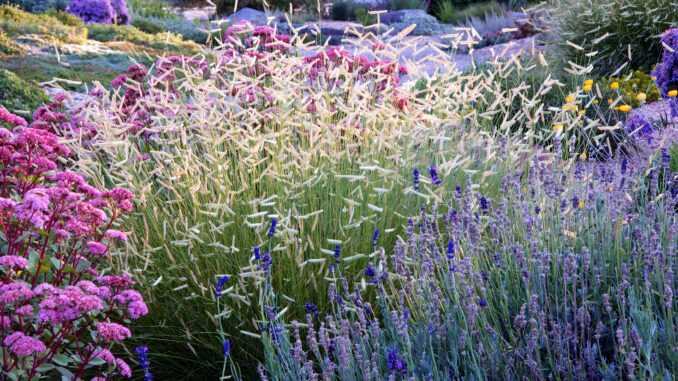
Alex Tisthammer | Fort Collins Nursery
One of the first and most valuable things I learned when I started in the Perennial Department of Fort Collins Nursery was from garden guru Gail McMahon. She taught me it’s important to have a consistent “theme” throughout your garden beds, whether it be a flower or leaf color, or a texture from the leaves. Having a consistent theme will help lead the eye around the garden and keep the viewer entertained. This is especially important in areas of the garden where you want to promote movement, like walkways, to lead people through. Your theme could be variegated, silver, or burgundy leaves, grasses with finely textured blades, or a consistent color throughout with different flowers. The convenience of choosing leaf color as your theme is that the leaves stay for most of the year, making the most out of the plants you have chosen, but as stated above, you can choose whatever strikes your fancy.
Color combinations, whether it be combinations of flowers or leaves, are equally important after you choose your theme. I personally am obsessed with cool blues and lavenders paired with pastel oranges, salmon, and corals. These two groups of colors are contrasting colors on the color wheel, hence why they look so good together and help one another pop. Other contrasting color groups are green/red, and yellow/purple. Think about what color flower you enjoy most and want to see a lot in your garden, and work from there.
Some gardeners choose to go a different way with their color combinations and choose either hot or cool colors. When I imagine a cottage garden, I imagine soft pastels, while tropical gardens are full of hot, vibrant colors. Pairing hot and cool colors together tends to wash the pastels out and make the vibrant ones seem out of place, so it’s best to stick with one or the other.
Another option to consider is monochrome gardens. The simple elegance of a moon garden can be just as striking as a landscape full of color, during the day and at night! Moon gardens are gardens planted with all-white flowers or plants with silver leaves. Both will reflect the moonlight and create an enchanting scene. On the other end of the spectrum, you could plant a goth garden full of only black flowers and leaves! There are quite a few plants on the market that are all black, including black iris or black coral bells, that would be perfect for a goth garden.
I have discovered that a lot of what I learned in art class about color theory also applies when designing a garden. Visualizing my garden as a cohesive work of art has improved how I select my color choices and how I arrange my garden beds. Having consistent design elements and colors that complement one another help create flow throughout a garden and makes it a more harmonious space to enjoy.
Support Northern Colorado Journalism
Show your support for North Forty News by helping us produce more content. It's a kind and simple gesture that will help us continue to bring more content to you.
BONUS - Donors get a link in their receipt to sign up for our once-per-week instant text messaging alert. Get your e-copy of North Forty News the moment it is released!
Click to Donate